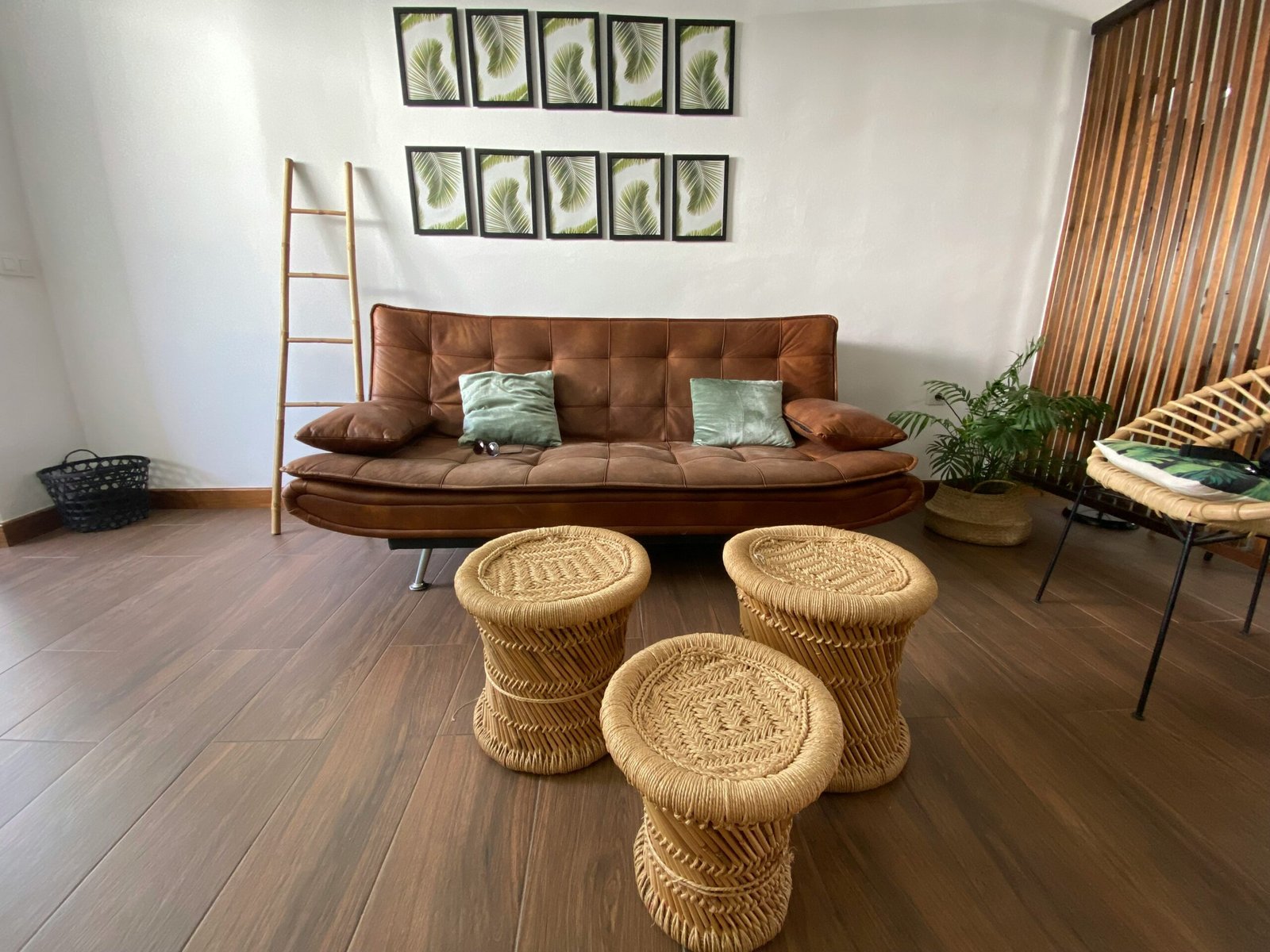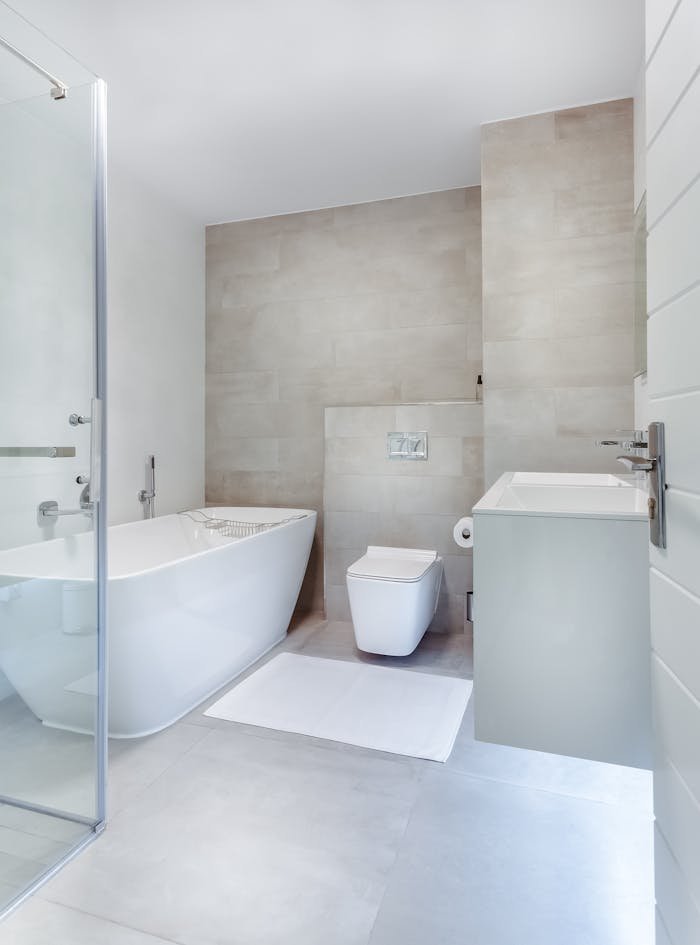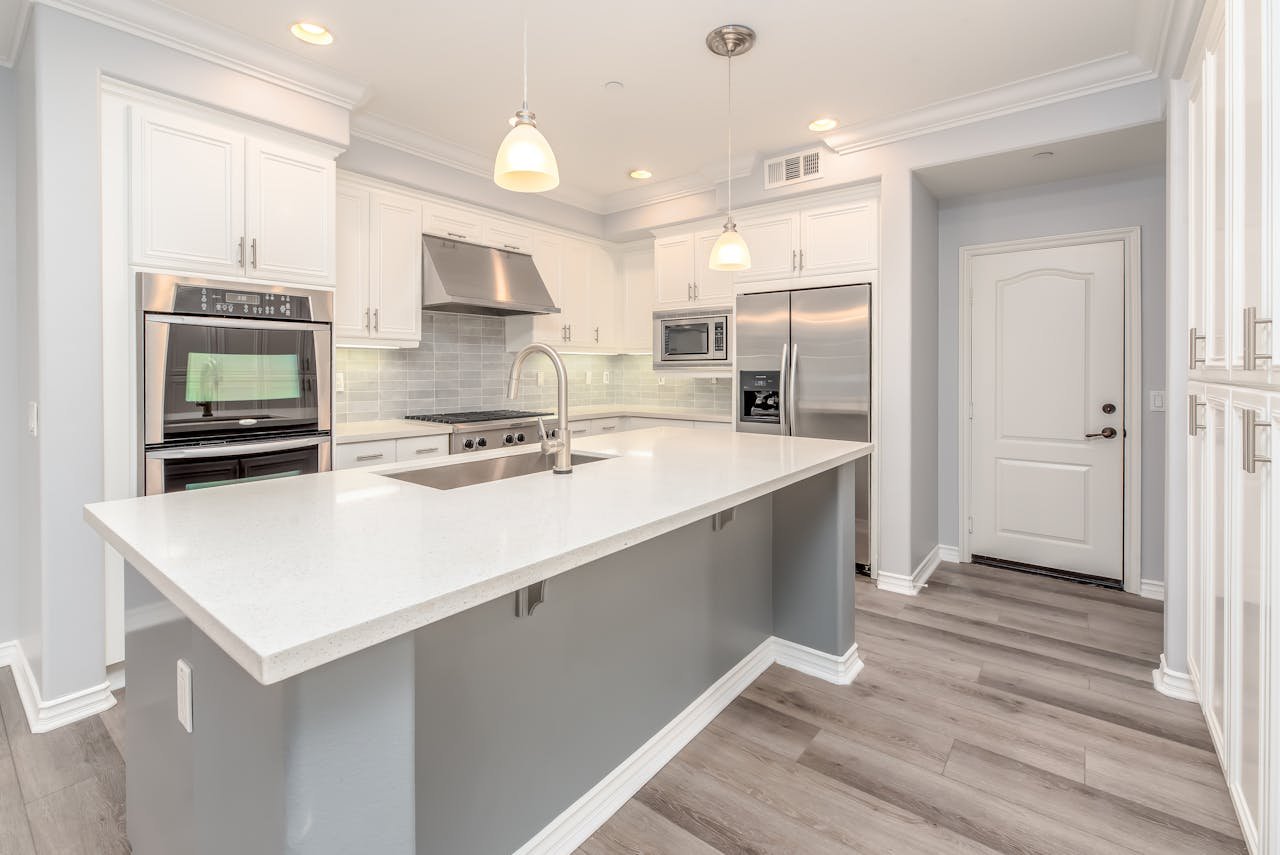NORTH VANCOUVER – Flooring sets the foundation for the aesthetic of your home. It has a significant impact on the look and feel of each room, so deciding on the type of flooring to install is important. Here, we’ll break down some of the most popular flooring options available, and the pros and cons of each, to help with your decision-making.
What Is the Best Flooring Type for Your Home?
The short answer is: there isn’t one. The best flooring material for your home depends on your preference, lifestyle, and the look you’re going for. Before deciding on a type of home flooring, you’ll want to ensure that you’ve thought in detail about your day-to-day lifestyle and how that could impact your decision-making. Let us explain.
If you have kids or pets, you’ll want to think about durability and ease of cleaning. You’ll want to choose a flooring material that is resistant to staining, scratching, and overall wear and tear. If you entertain often, you’ll have similar considerations. If you have a pool or hot tub, you’ll want to think about slip resistance on any floors near the access to those features and choosing a flooring that is entirely waterproof. If you prefer low maintenance, flooring that doesn’t require refinishing or resurfacing is ideal. Perhaps you find carpet in the bedrooms to be cozier, or you want to choose a material with eco-friendly qualities. All of these considerations will factor into your flooring choice.
Below are the most popular flooring materials for home interiors:
- Wood Flooring
- Bamboo Flooring
- Porcelain Floor Tile
- Natural Stone Floors
- Cork Flooring
- Linoleum Flooring
- Concrete Floors
- Carpet
- Laminate Flooring
- Vinyl Flooring
Read on for some helpful information to help you decide which flooring material is right for you.
1. Wood Flooring
Wood flooring is a timeless option that has rightly taken its place as one of the most popular flooring choices for any home. Wood adds warmth and character to your home and comes in a variety of colors and types to give you exactly what you’re looking for.
Hardwood Floors
True hardwood flooring is a solid plank with no fillers or integrated layers. These floors are long-lasting, even for decades with proper care. Because it’s solid wood from top to bottom, you can sand and re-stain it for a fresh look, usually up to ten times. This means pure hardwood can last up to 100 years!
Examples of common hardwood species include oak, maple, birch, hickory, cherry, pine, douglas fir, and walnut. Different species of hardwood have different hardness levels. Softer woods will scratch more easily, so it’s important to know the rating for each type of hardwood you’re considering. The industry standard for hardness ratings is the Janka Hardness Scale, which measures the ability of wood to withstand denting.
The downside of hardwood is often the cost, which varies depending on the species. Hardwood floors can also be prone to scratches and dents, but reclaimed wood floors have more grain and markings that help hide any imperfections. Hardwood is water-resistant, but not waterproof, so keep this in mind for areas near the kitchen or entryway. The maintenance of sanding and refinishing hardwood floors can also be a turn-off for some homeowners, but others enjoy the versatility, natural beauty, and sustainability of hardwood.
Engineered Wood Floors
Engineered wood is a modern advancement in flooring. It’s generally comprised of a plywood core and a thin layer of hardwood that is bonded to the top. Engineered wood floors are more water-resistant than hardwood, though not waterproof. For this reason, they are a common flooring choice in high-moisture environments such as kitchens, bathrooms, and basements.
The biggest benefit of engineered wood floors is the dimensional stability—they’ll shift and warp less over time and be resistant to changes in temperature. They also are typically more resistant to daily wear and tear.
Engineered hardwood floors can only be refinished 1-3 times before needing replacement, so they are not necessarily as sustainable as pure hardwood floors. They may last up to 30 years.
2. Bamboo Flooring
If sustainability is important to you, bamboo flooring is one of the most eco-friendly flooring choices you can make for your home. Bamboo is the fastest growing plant on Earth, and therefore highly renewable. Bamboo is also harder and more durable than some hardwoods like oak or ash and can be less expensive than hardwood.
Despite all the advantages, hardwood is generally expected to last longer than bamboo. The longevity difference may be negligible though. Both flooring types withstand dents and scratches similarly.
More and more bamboo options are available every year, with stains to match any interior. The natural grain of bamboo, however, is a single look. Bamboo tends to have long, linear grain lines and does not have heartwood or growth rings, so the appearance is a more uniform look than traditional wood flooring.
3. Porcelain Floor Tile
Tile flooring is a great option for active homes in just about any part of the home and is certainly one of the most popular flooring choices. Its durability and water resistance make it ideal for kitchens and bathrooms. The variety of colors, patterns, and natural stone imitation looks it comes in means there are options for every aesthetic. A tile floor is also very easy to clean and maintain, especially if you use epoxy grout with it.
Porcelain tile is comprised of a fine and pure kaolin clay mixture. This mixture makes porcelain tile denser and more impervious to water than ceramic tile. Porcelain tile is almost always rated for use in wet environments like bathroom floors or kitchen backsplashes. With a never-ending selection of colors, glazes, sizes, and styles, it’s easy to find a porcelain floor tile to fit your space. Porcelain tiles are even made to mimic other materials, like wood or concrete, but with much better water resistance.
While all tile is typically a durable material, tile can be prone to cracking and chipping if something heavy is dropped on it; an important consideration when choosing between porcelain and ceramic. Porcelain tile has what is called a ‘through body color’ so if it chips, the underlayer that shows will look fairly close to the rest of the tile (without the printed pattern or texture). Ceramic tiles are essentially a topcoat on a clay base, so if you have a white ceramic tile that chips you’ll see a grey or orange spot in that location. For these reasons, we recommend porcelain for most flooring projects.
4. Natural Stone Floors
There are many different natural stone types to consider for flooring, including slate, granite, marble, limestone, and travertine to name a few. Natural stone is durable, strong, and common in luxury homes. Stone floors are considered an investment and often add significant value to a home but can be costly and are not easily changed.
Natural stone flooring is common in contemporary Pacific Northwest interior design, mimicking the natural environment that surrounds us. When shopping for natural stone flooring, it’s important to consider the grade, absorption rating, and finish of each option.
5. Cork Flooring
Cork flooring is made from the highly regenerative bark of the cork oak tree and is one of the most sustainable flooring options there is. Just like the cork of a wine bottle, cork flooring is soft and insulating. Cork flooring is made as either glue-down tiles or click-together planks and is typically easy to replace if needed. Cork flooring options are extremely versatile, made in a variety of colors, patterns, shapes, and hues. Some colored cork doesn’t even resemble cork, but rather a tile or painted floor—with plenty of added comfort.
Cork is exceptionally quiet underfoot, environmentally friendly, comfortable, and serves as a natural thermal insulator. It’s especially suited for basements, home gyms, or playrooms. Though cork may wear or dent faster than other flooring materials, the environmental benefits outweigh these potential issues in most scenarios. Due to the natural pattern of cork, any dents or scratches will be far less noticeable than other flooring materials. Plus, when your cork floors have reached the end of their useful product life, cork is a natural and biodegradable material.
Cork flooring can be sealed to prevent moisture absorption and staining, and some cork flooring is even 100% waterproof. Sometimes cork floors, depending on the manufacturer, can even be refinished like hardwood can.
6. Linoleum Flooring
Often mistaken with vinyl flooring, linoleum is a different flooring material altogether. Linoleum flooring is a highly durable and flexible mix of renewable natural materials that may include linseed oil, jute, cork powder, limestone, tree resin, and wood flours. The resulting material is strong and soft at the same time, requires little care, has natural water resistance, and is easy to clean.
For homeowners that want the absolute most sustainable option in linoleum, we recommend Forbo’s Marmoleum. This worldwide brand is known for its eco-friendly materials and manufacturing processes. While linoleum flooring is more expensive than vinyl flooring and must be professionally installed, it’s a healthier option overall.
7. Concrete Flooring
Poured concrete is an economical and durable flooring option for the lower level of any home. Concrete is extremely low-maintenance, durable, and resistant to stains or scratching. Over time, even expertly poured concrete is susceptible to cracking, but sometimes patching can be done. A concrete floor is especially suited towards industrial or farmhouse décor but can be the foundation of many different styles. Like with tile, electric or hydronic heating can be installed to warm up the naturally cold feel of concrete.
If you want to install concrete over a subfloor supported by joists, you’ll need to consult a structural engineer to determine if your floor can bear the weight. If concrete is not an option on a higher floor, a similar look can be achieved with concrete-look tile.
8. Carpet
While carpet may have seen its heyday as the primary flooring choice throughout a home, it’s still a popular choice for areas like bedrooms, nurseries, and living rooms. It adds a softness, warmth, and acoustic privacy aspect that other floors strive for. Carpet comes in a variety of textures, colors, and styles, giving you ultimate flexibility.
As wonderful as carpet is, it can be a high-maintenance flooring material. Because it is absorbent, carpet can be prone to staining and may require professional cleaning to keep it looking nice. This is particularly true in high-traffic areas, for those who entertain, or have kids and/or pets. Avoid carpet anywhere that is high moisture, like bathrooms and kitchens. We always recommend enlisting the help of the carpet salesperson or an interior designer to guide you towards the best carpet for your lifestyle needs.
For an eco-friendly and healthy carpet option, we always steer clients towards wool. It’s a renewable resource, biodegradable, low or no-VOC, and very durable. Wool carpet also has natural insulting properties that synthetic carpet can’t match, which makes sense given that wool needs to keep sheep warm throughout the year. While wool carpet is more expensive than synthetic carpet, we truly believe it’s worth the upgrade and will last many times longer.
9. Laminate Flooring
Laminate flooring is a great choice for those who love the look of hardwood floors without the cost and maintenance that comes along with it. Laminate is traditionally made up of four different layers, including a foam backer, fiberboard core, printed image layer, and a clear sealant overtop. The layers are combined in a process called lamination—hence the name.
The majority of laminate flooring is synthetic materials, making it durable and resistant to scratches, dents, or staining, but not necessarily an environmentally friendly choice. Before committing to laminate it’s essential to know that quality makes a difference. Low-quality, and often low-cost, options can look cheap or fake if you’re not careful. These floors are also not as long-lasting as other options. While they’re durable, the edges can be prone to chipping and damage, especially during installation.
10. Vinyl Flooring
Vinyl flooring is another economical flooring option with a lot of versatility. Available in numerous colors and styles, a high-quality luxury vinyl plank in a natural hue will wear very well—providing you with years of low-maintenance enjoyment. Most of today’s luxury vinyl is almost indecipherable from hardwood and at a much lower price point. Vinyl is also available in tile or sheet form.
If your home gets a lot of foot traffic (kids, pets, etc.), a luxury vinyl plank (LVP) floor is a great choice. LVP is referred to interchangeably as Luxury Vinyl Flooring (LVF). Luxury vinyl is softer and warmer on the foot than concrete. It withstands spills and moisture very well. It’s not completely waterproof like sheets of vinyl, but still works well in basements and bathrooms. Keep in mind that vinyl is a synthetic plastic. It is one of the least eco-friendly materials on this list and may have high levels of VOCs that can pollute indoor air quality. For this reason, we typically recommend using vinyl flooring in areas with less foot traffic.
Choosing the Right Flooring for Your Home
When selecting flooring, it’s essential to consider your lifestyle, personal preferences, and the specific needs of each room in your home. Whether you opt for the timeless elegance of hardwood, the eco-friendly appeal of bamboo, the durability of porcelain tiles, or the comfort of carpet, each material offers unique benefits and drawbacks.
Consult with professionals to ensure the best fit for your home, and enjoy the process of transforming your space with beautiful, functional flooring that suits your style and needs.
Ready to Upgrade Your Floors?
Northedge Construction is here to help you select and install the perfect flooring for your home. Contact us today to start your flooring journey and transform your space with the latest trends and materials.



